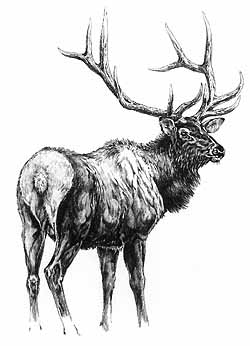English: Wapiti or Elk; French: Wapiti; Chinese: Tian, shan-ma-lu, Ala-shan-ma-lu, Bai-tun-lu; Cree: Wawaskisu; Dogrip: molakwo; Mongolian: Maral Buga; Russian: Altajsskij Maral; South Slavey: jedhi.
 |
Former distribution: Northern and central Canada south to the western and coastel USA, to northern Mexico, east to the Atlantic coasts. In the Nearctic region. In the Palaearctic from the Tienshan Mountains east to northern China, Mongolia, Heilongjiang, Amur-Ussuri region, North Korea, and Xizang (Tibet) in China, and central China.
Present distribution: Nearctic: western North America from British Columbia and Alberta south to Arizona and New Mexico, and in parts of Manitoba and Saskatchewan; reintroduced into Ontario, Michigan and Pennsylvania, to the Afoknak Island in Alaska, also to New Zealand. Palaearctic: From the Tienshan east to the Altai, (Dzungaria), northern Xinjiang (Sinkiang), northern and eastern Mongolia, Baikal and Transbaikal to Amur-Ussuri region, North Korea, in China in Heilongjiang (Manchuria), Jilin in northern China, Gansu (Kansu) and Xizang (Tibet). Introduced into Spain; New Zealand.
Behaviour: Preferred habitat: grasslands and open forests in low and mountainous regions; gregarious; the sexes separate most of the year. Wapitis graze and browse grass, leaves and twigs from deciduous trees. Activity mainly at twilight; the rut takes place in September and October. Migrating occurs from the summer grounds to the winter feeding places. Predators include wolves, occasionally brown bears and pumas.
Population status: Stable, except the Tule Elk, Cervus c. nannodes, in California is endangered: 2000. Total estimated number in North America: 770 000. Extinct are: Cervus c. merriam.
Brief notes:
Body weight: 300-500 kg
Head and body length: 200-250 cm
Tail length: 12-15 cm
Shoulder height: 130-160 cm
Gestation period: 230-240 days
Maximum age: 15-18 years
Trophy: Record SCI: Cervus c. nelsoni: 391 4/8 score, 1984 USA, Arizona, JERRY DAVIS; average 220 score. Cervus c. roosevelti: 302 3/8 score, 1984 USA, WA., PAUL INZANTI jr.; average 200 score. Cervus c. nannodes: 137 1/8 score, 1965 USA, California, JEAN CLARKE. Cervus c. asiaticus: 306 2/8 score, 1982 Mongolia, Dr. MARIO VINCENZI; average 200 score. B&C: Cervus c. nelsoni: 442 3/8 score, 1899 USA, Colorado, JOHN PLUTE; average 375 score. RW’s: Cervus c. sibiricus: 412 3/4 points, 1966 USSR, Kirg.; average 190 points. Cervus c. macnelli: 45 3/4″, 1933 China, Kansu, C. OSWALD LIDELL.
Hunting methods: Stalking, on horseback, with dogs.
Subspecies: 7. The author follows the reclassification of WEMMER (1982) for the Wapiti – Canadensis group, but is using the definition of Cervus canadensis and not elaphus – for familiar species.
1. American Wapiti or Elk Cervus c. canadensis, syn. roosevelti, manitobenis, nelsoni Alaska, Canada, USA. Stable. Estimated numbers: 768 000.
2. Merriam’s Wapiti Cervus c. merriami Arizona, New Mexico, Texas, northern Mexico. Extinct 1906.
3. Dwarf Wapiti or Tule Elk Cervus c. nannodes West-central California. Endangered. Estimated numbers: 2000.
4. Siberian Wapiti Cervus c. sibiricus North-western and south-eastern Mongolia, Altai region and Baikal region in the USSR. Stable. Estimated numbers: USSR 160-180 000; northern Mongolia 150 000 acc. to KRUPKA 1984 in lit.
5. Tien Shan Wapiti Cervus c. songaricus USSR Tien-Shan, Alatau, Dzungaria, Chinese Tien Shan, western Mongolia, in Xingjiang (Sinkiang). Stable. Estimated numbers: No records.
6. Ala Shan Wapiti Cervus c. alashanicus Horan Shan (Ala Shan), (Kansu), west Nei Monggol. Stable. Estimated numbers: 4-5000 (pers. comm. BAI LIYIN; in lit: OSWALD 1988).
7. Isubra Cervus c. xanthopygus Transbaikal in the USSR east to Amur-Ussuri region, northern Korea, in Heilongjiang (Manchuria) and northern China and eastern Mongolia. Stable. Estimated numbers: No records.
Remarks: The reclassification does not correspond to the taxonomic definition for the evaluation of trophies as from SCI, RW’s, B&C and CIC. The distribution area of the Asiatic Wapiti is still not well known; more information on population status and distribution required.






